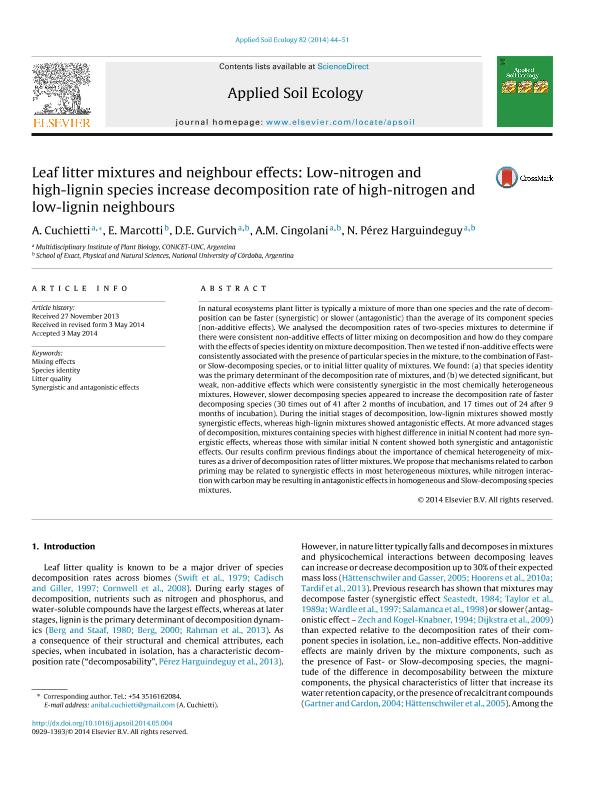Mostrar el registro sencillo del ítem
dc.contributor.author
Cuchietti, Anibal

dc.contributor.author
Marcotti, Eugenia

dc.contributor.author
Gurvich, Diego Ezequiel

dc.contributor.author
Cingolani, Ana María

dc.contributor.author
Pérez Harguindeguy, Natalia

dc.date.available
2017-08-16T19:26:54Z
dc.date.issued
2014-05
dc.identifier.citation
Cuchietti, Anibal; Marcotti, Eugenia; Gurvich, Diego Ezequiel; Cingolani, Ana María; Pérez Harguindeguy, Natalia; Leaf litter mixtures and neighbour effects: Low-nitrogen and high-lignin species increase decomposition rate of high-nitrogen and low-lignin neighbours; Elsevier Science; Applied Soil Ecology; 82; 5-2014; 44-51
dc.identifier.issn
0929-1393
dc.identifier.uri
http://hdl.handle.net/11336/22542
dc.description.abstract
In natural ecosystems plant litter is typically a mixture of more than one species and the rate of decomposition can be faster (synergistic) or slower (antagonistic) than the average of its component species(non-additive effects). We analysed the decomposition rates of two-species mixtures to determine if there were consistent non-additive effects of litter mixing on decomposition and how do they compare with the effects of species identity on mixture decomposition. Then we tested if non-additive effects were consistently associated with the presence of particular species in the mixture, to the combination of Fast-or Slow-decomposing species, or to initial litter quality of mixtures. We found: (a) that species identity was the primary determinant of the decomposition rate of mixtures, and (b) we detected significant, but weak, non-additive effects which were consistently synergistic in the most chemically heterogeneous mixtures. However, slower decomposing species appeared to increase the decomposition rate of faster decomposing species (30 times out of 41 after 2 months of incubation, and 17 times out of 24 after 9 months of incubation). During the initial stages of decomposition, low-lignin mixtures showed mostly synergistic effects, whereas high-lignin mixtures showed antagonistic effects. At more advanced stages of decomposition, mixtures containing species with highest difference in initial N content had more synergistic effects, whereas those with similar initial N content showed both synergistic and antagonistic effects. Our results confirm previous findings about the importance of chemical heterogeneity of mixtures as a driver of decomposition rates of litter mixtures. We propose that mechanisms related to carbon priming may be related to synergistic effects in most heterogeneous mixtures, while nitrogen interaction with carbon may be resulting in antagonistic effects in homogeneous and Slow-decomposing species mixtures.
dc.format
application/pdf
dc.language.iso
eng
dc.publisher
Elsevier Science

dc.rights
info:eu-repo/semantics/openAccess
dc.rights.uri
https://creativecommons.org/licenses/by-nc-sa/2.5/ar/
dc.subject
Mixing Effects
dc.subject
Species Identity
dc.subject
Litter Quality
dc.subject
Synergistics And Antagonistic Effects
dc.subject.classification
Bioquímica y Biología Molecular

dc.subject.classification
Ciencias Biológicas

dc.subject.classification
CIENCIAS NATURALES Y EXACTAS

dc.subject.classification
Bioquímica y Biología Molecular

dc.subject.classification
Ciencias Biológicas

dc.subject.classification
CIENCIAS NATURALES Y EXACTAS

dc.title
Leaf litter mixtures and neighbour effects: Low-nitrogen and high-lignin species increase decomposition rate of high-nitrogen and low-lignin neighbours
dc.type
info:eu-repo/semantics/article
dc.type
info:ar-repo/semantics/artículo
dc.type
info:eu-repo/semantics/publishedVersion
dc.date.updated
2017-08-01T14:05:59Z
dc.journal.volume
82
dc.journal.pagination
44-51
dc.journal.pais
Países Bajos

dc.journal.ciudad
Amsterdam
dc.description.fil
Fil: Cuchietti, Anibal. Consejo Nacional de Investigaciones Científicas y Técnicas. Centro Científico Tecnológico Conicet - Córdoba. Instituto Multidisciplinario de Biología Vegetal. Universidad Nacional de Córdoba. Facultad de Ciencias Exactas Físicas y Naturales. Instituto Multidisciplinario de Biología Vegetal; Argentina
dc.description.fil
Fil: Marcotti, Eugenia. Universidad Nacional de Córdoba. Facultad de Cs.exactas Físicas y Naturales. Departamento de Diversidad Biológica y Ecologica; Argentina. Consejo Nacional de Investigaciones Científicas y Técnicas; Argentina
dc.description.fil
Fil: Gurvich, Diego Ezequiel. Consejo Nacional de Investigaciones Científicas y Técnicas. Centro Científico Tecnológico Conicet - Córdoba. Instituto Multidisciplinario de Biología Vegetal. Universidad Nacional de Córdoba. Facultad de Ciencias Exactas Físicas y Naturales. Instituto Multidisciplinario de Biología Vegetal; Argentina
dc.description.fil
Fil: Cingolani, Ana María. Consejo Nacional de Investigaciones Científicas y Técnicas. Centro Científico Tecnológico Conicet - Córdoba. Instituto Multidisciplinario de Biología Vegetal. Universidad Nacional de Córdoba. Facultad de Ciencias Exactas Físicas y Naturales. Instituto Multidisciplinario de Biología Vegetal; Argentina
dc.description.fil
Fil: Pérez Harguindeguy, Natalia. Consejo Nacional de Investigaciones Científicas y Técnicas. Centro Científico Tecnológico Conicet - Córdoba. Instituto Multidisciplinario de Biología Vegetal. Universidad Nacional de Córdoba. Facultad de Ciencias Exactas Físicas y Naturales. Instituto Multidisciplinario de Biología Vegetal; Argentina
dc.journal.title
Applied Soil Ecology

dc.relation.alternativeid
info:eu-repo/semantics/altIdentifier/doi/http://dx.doi.org/10.1016/j.apsoil.2014.05.004
dc.relation.alternativeid
info:eu-repo/semantics/altIdentifier/url/http://www.sciencedirect.com/science/article/pii/S0929139314001528
Archivos asociados
